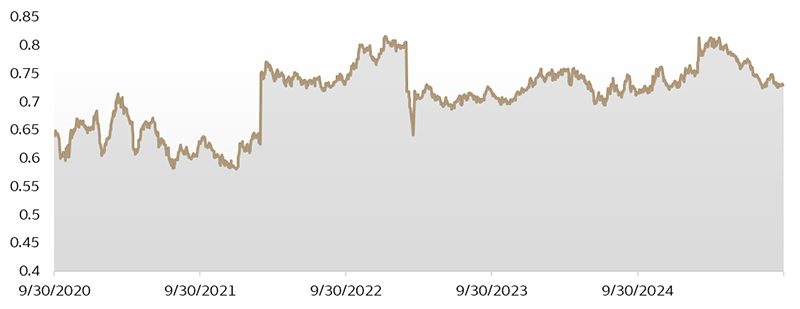October 7, 2025
Laurie Harlan Cheek, Equity Analyst
Our favorite sector as the yield curve steepens
 Sources: FactSet and Wells Fargo Investment Institute. Data as of September 29, 2025. P/E = price to earnings. An index is unmanaged and not available for direct investment. Past performance is no guarantee of future results. Excerpted from Investment Strategy (October 6, 2025)
Sources: FactSet and Wells Fargo Investment Institute. Data as of September 29, 2025. P/E = price to earnings. An index is unmanaged and not available for direct investment. Past performance is no guarantee of future results. Excerpted from Investment Strategy (October 6, 2025)Financials sector forward price to earnings (P/E) relative to the S&P 500 Index forward P/E
The Financials sector remains one of the most attractively positioned areas of the market as we approach year-end, in our view. Banks have strong balance sheets, diversified lending portfolios, and fee-based revenue streams that provide ballast against changing interest-rate dynamics. We see payments and fintech firms continuing to lead long-term digitization and embedded finance trends; insurers benefiting from disciplined underwriting and elevated reinvestment yields; and asset managers capturing flows into income strategies and alternative investments.
Valuation is a key advantage. As the chart shows, Financials (as of September 30, 2025) have been trading at a significant discount to the S&P 500 Index. We believe the steepening of the yield curve adds another tailwind — banks benefit from wider spreads on new lending, insurers can reinvest at higher rates, and asset managers stand to capture renewed flows into fixed income, potentially narrowing the valuation gap.
What it may mean for investors
We believe investors seeking income or diversification from more growth-oriented allocations may want to consider increased exposure to the Financials sector, given its attractive valuation and the improving macroeconomic backdrop. We believe the steepening yield curve and improving capital markets backdrop has the potential to support earnings momentum across several of our favorable sub-sectors, including Diversified Banks, Capital Markets, Transaction & Payment Processing Services, Property & Casualty Insurance, and Insurance Brokers.
Risk Considerations
Each asset class has its own risk and return characteristics. The level of risk associated with a particular investment or asset class generally correlates with the level of return the investment or asset class might achieve. Stock markets, especially foreign markets, are volatile. Stock values may fluctuate in response to general economic and market conditions, the prospects of individual companies, and industry sectors.
Sector investing can be more volatile than investments that are broadly diversified over numerous sectors of the economy and will increase a portfolio’s vulnerability to any single economic, political, or regulatory development affecting the sector. This can result in greater price volatility. Investing in the Financial services companies will subject an investment to adverse economic or regulatory occurrences affecting the sector.
General Disclosures
Global Securities Research (GSR) is a division of Wells Fargo Investment Institute, Inc. (WFII). WFII is a registered investment adviser and wholly owned subsidiary of Wells Fargo Bank, N.A., a bank affiliate of Wells Fargo & Company.
The information contained herein constitutes general information and is not directed to, designed for, or individually tailored to, any particular investor or potential investor. This report is not intended to be a client-specific suitability or best interest analysis or recommendation, an offer to participate in any investment, or a recommendation to buy, hold or sell securities. Do not use this report as the sole basis for investment decisions. Do not select an asset class or investment product based on performance alone. Consider all relevant information, including your existing portfolio, investment objectives, risk tolerance, liquidity needs and investment time horizon. The material contained herein has been prepared from sources and data we believe to be reliable but we make no guarantee to its accuracy or completeness.
Wells Fargo Advisors is registered with the U.S. Securities and Exchange Commission and the Financial Industry Regulatory Authority, but is not licensed or registered with any financial services regulatory authority outside of the U.S. Non-U.S. residents who maintain U.S.-based financial services account(s) with Wells Fargo Advisors may not be afforded certain protections conferred by legislation and regulations in their country of residence in respect of any investments, investment transactions or communications made with Wells Fargo Advisors.
Wells Fargo Advisors is a trade name used by Wells Fargo Clearing Services, LLC and Wells Fargo Advisors Financial Network, LLC, Members SIPC, separate registered broker-dealers and non-bank affiliates of Wells Fargo & Company.
©2025 Wells Fargo Investment Institute and subject to the CC BY-NC-ND 4.0 DEED. All rights reserved.


